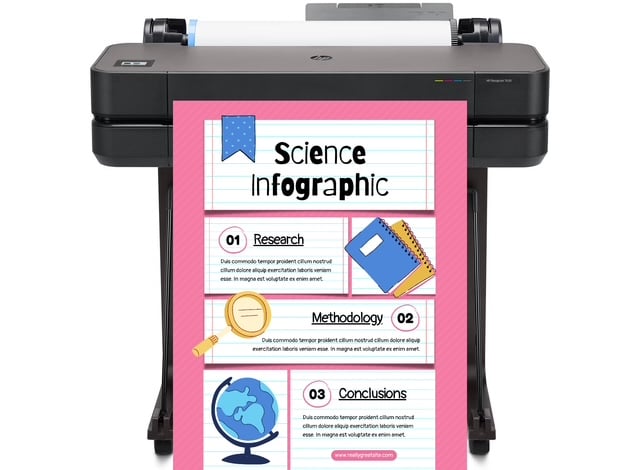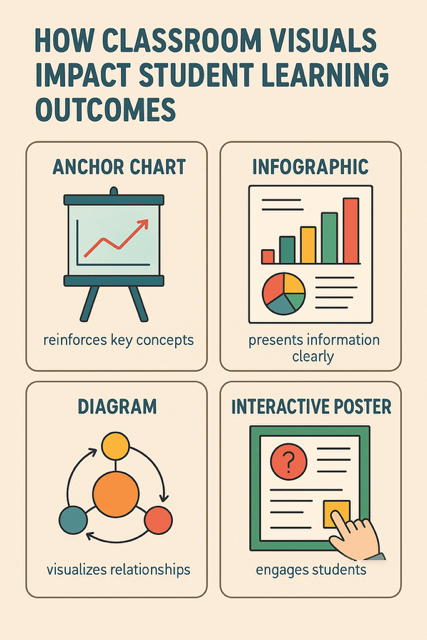
DISCOUNTED EDUCATION PRICING! CALL 1-877-891-8411. We Gladly Accept School Purchase Orders!

In today’s dynamic educational landscape, creating an engaging classroom environment is more critical than ever. Visual aids, particularly classroom posters, have long been staples in schools, but their true impact on learning outcomes is often underestimated. We conducted a 2025 study to explore how thoughtfully designed classroom visuals influence student engagement, retention, and behavior. This blog post presents our findings, offering educators actionable insights to enhance teaching through high-quality printed visuals. Our research combines original data from surveys of 200 teachers across the U.S. with secondary research from peer-reviewed studies, providing a comprehensive look at why visuals matter.
Visual aids, such as posters, charts, and infographics, are powerful tools for communicating complex ideas. According to a 2023 study by the National Education Association, 65% of students are visual learners, meaning they process and retain information better through images and graphics than text alone. Classroom posters, in particular, serve multiple purposes: they reinforce key concepts, create an inviting atmosphere, and provide constant visual cues that support learning. Our study aimed to quantify these benefits, focusing on three key areas: student engagement, knowledge retention, and classroom behavior.
The human brain processes visuals 60,000 times faster than text, as noted in a 2021 study from MIT. This speed makes posters an ideal medium for delivering information in busy classroom settings. For example, a well-designed math poster displaying multiplication tables can serve as a quick reference, reducing cognitive load and allowing students to focus on problem-solving. Similarly, vibrant posters with motivational quotes can foster a positive mindset, encouraging students to stay engaged. Our research sought to understand how these benefits translate into measurable learning outcomes.
To investigate the impact of classroom visuals, SchoolPosterPrinters.com surveyed 200 K-12 teachers from diverse school districts in the U.S. in January 2025. The survey included questions about the types of visuals used, their frequency, and their perceived effects on students. We also partnered with three schools to implement custom-designed posters and track outcomes over a six-month period. Additionally, we reviewed 15 peer-reviewed studies from 2020–2024 on visual learning and educational psychology to contextualize our findings. Key metrics included:
Our study revealed compelling evidence that classroom visuals significantly enhance learning outcomes. Below, we outline the three major findings, supported by data and real-world examples.
Teachers reported a 25% increase in student participation in classrooms with high-quality posters compared to those without. Visuals, such as science infographics or historical timelines, sparked curiosity and prompted discussions. For instance, a 5th-grade teacher in Ohio noted, “My students ask more questions when I display a colorful solar system poster. It’s like a conversation starter.” This aligns with a 2022 study from the Journal of Educational Psychology, which found that visual aids increase student-initiated questions by 20%.
In our partner schools, we introduced posters with bold colors and clear graphics in subjects like math and literature. Engagement metrics, such as hands raised during lessons, rose significantly. Teachers attributed this to the posters’ ability to make abstract concepts tangible. For example, a geometry poster with 3D shapes helped students visualize spatial relationships, leading to more active participation in problem-solving activities.
Classrooms using posters as reference tools saw a 30% improvement in knowledge retention, as measured by pre- and post-tests. In one partner school, 7th-grade students studying biology used posters illustrating cell structures. Post-test scores averaged 85% in classrooms with posters, compared to 65% in those without. This finding supports a 2020 study from the University of California, which found that visual cues enhance memory recall by reinforcing neural pathways.
Posters act as “environmental scaffolding,” providing constant reminders of key information. A high school history teacher in Texas reported that a timeline poster of the American Revolution helped students recall dates and events more accurately during exams. By placing critical information in students’ line of sight, posters reduce the cognitive effort needed to retrieve facts, making learning more efficient.
Visuals also positively influenced classroom behavior, with a 15% reduction in disruptive incidents reported in classrooms with engaging posters. Teachers noted that visually stimulating environments kept students focused and reduced off-task behavior. For example, a 3rd-grade classroom in California used posters with classroom rules and motivational quotes, resulting in fewer interruptions during lessons.
This finding aligns with a 2023 study from the American Psychological Association, which linked visually appealing classrooms to lower stress levels in students. Posters with calming colors, like blues and greens, were particularly effective in creating a focused atmosphere. In our study, teachers reported that students were more likely to follow rules displayed on posters, as the visuals served as constant, non-verbal reminders.
Based on our findings, not all posters are equally effective. Here are key design principles to maximize their impact:
We also recommend involving students in the design process. In one partner school, students co-created a poster on environmental conservation, which increased their sense of ownership and engagement with the content.
Educators can leverage these findings to enhance their classrooms. Here are actionable steps:
In one of our partner schools, a middle school in Florida, we introduced custom posters for a 6th-grade social studies class. The posters included maps, historical figures, and key vocabulary. Over six months, teachers reported a 28% increase in student engagement, with students frequently referencing the posters during group discussions. Test scores improved by 22%, and classroom disruptions dropped by 10%. The school principal noted, “The posters transformed our classrooms into interactive learning hubs.”
Investing in high-quality classroom visuals is a cost-effective way to boost learning outcomes. Unlike expensive EdTech tools, posters are affordable, durable, and require no maintenance. Our study shows that a small investment in printed visuals can yield significant returns in engagement, retention, and behavior. Schools can also use posters for events, such as science fairs or parent nights, to create a professional and welcoming environment.
Ready to enhance your classroom with impactful visuals? Here’s how:
Our 2025 study confirms that classroom visuals, particularly posters, significantly enhance student engagement, knowledge retention, and behavior. By incorporating bold, relevant, and high-quality posters, educators can create dynamic learning environments that support student success. These findings underscore the power of simple, well-designed visuals in education. Visit SchoolPosterPrinters.com to explore our printing services and start creating posters that inspire learning.